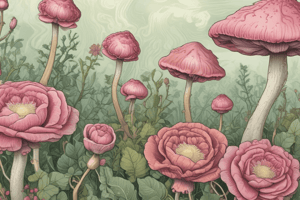Podcast
Questions and Answers
Where are the polypoid masses typically found in patients with lobomycosis?
Where are the polypoid masses typically found in patients with lobomycosis?
- Skin, muscles, bones, and liver
- Lungs, kidneys, and pancreas
- Brain, heart, and stomach
- Nasal mucosa, conjunctiva, genitalia, and rectum (correct)
How is lobomycosis typically acquired?
How is lobomycosis typically acquired?
- Through human-to-human transmission
- Through minor scratches or insect bites from the environment (correct)
- Through contaminated food and water
- Through airborne transmission
Which of the following is NOT a characteristic of lobomycosis?
Which of the following is NOT a characteristic of lobomycosis?
- It is found mainly in South America, particularly in Brazil
- It is a rare chronic fungal infection
- It affects humans and members of the Delphinidae family
- It is highly contagious (correct)
What is the primary mode of infection of Sporotrichosis?
What is the primary mode of infection of Sporotrichosis?
What is the name of the fungal agent that causes lobomycosis?
What is the name of the fungal agent that causes lobomycosis?
Why is lobomycosis considered an enigmatic illness?
Why is lobomycosis considered an enigmatic illness?
What is the typical incubation period of Sporotrichosis?
What is the typical incubation period of Sporotrichosis?
What is the name of the fungus that causes Sporotrichosis?
What is the name of the fungus that causes Sporotrichosis?
What is the name of the disease that affects the mucous membranes of the nasopharynx, oropharynx, conjunctiva, rectum, and external genitalia?
What is the name of the disease that affects the mucous membranes of the nasopharynx, oropharynx, conjunctiva, rectum, and external genitalia?
What is the class that Rhinosporidium seeberi is currently classified under?
What is the class that Rhinosporidium seeberi is currently classified under?
Who are the occupational groups most at risk of getting Sporotrichosis?
Who are the occupational groups most at risk of getting Sporotrichosis?




